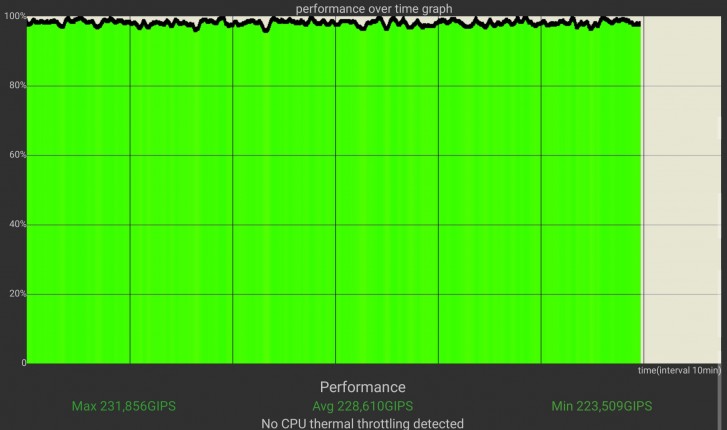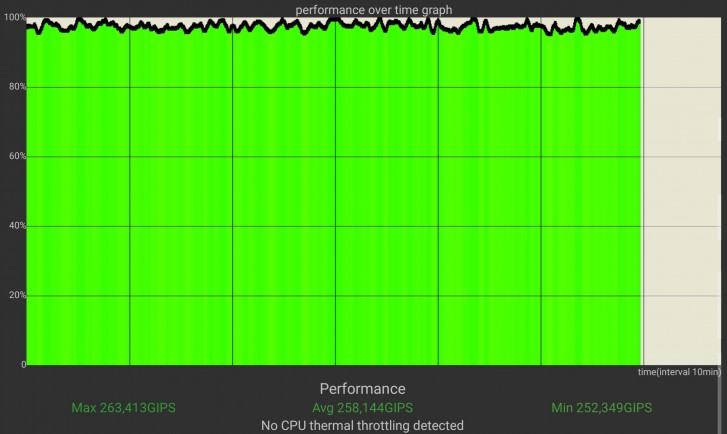nubia Red Magic 5G review

Synthetic benchmarks
The Red Magic 5G is running the latest hardware from Qualcomm for flagship phones - the Snapdragon 865 chipset paired with the Snapdragon X55 for 5G connectivity. In other words, nothing that we haven't seen before. We know what to expect from the SoC in terms of raw, synthetic performance, but the interesting part is the sustained and gaming performance. But before we jump into that, let's go through the hardware one more time and also run a couple of our regular benchmark tests to put things in context.

The Snapdragon 865, based on the 7nm+ EUV manufacturing process, comes with an octa-core CPU employing one big Kryo 585 core ticking at 2.84GHz, three of the same cores running at 2.42GHz and 4x Kryo 585 cores taking care of the not-so-demanding tasks with 1.8GHz clock speed. An Adreno 650 GPU is used for graphically-intensive tasks.
Also, nubia is making a great deal out of the memory configurations. The RAM can go up to 16GB LPDDR5, which is about 1.5x faster than LPDDR4X memory. For storage, the Red Magic 5G can go up to 256GB UFS 3.0, and that last bit is more than welcome since it decreases the load times of games. Not by a lot but it's reassuring that you can return to battle faster if something goes sideways.
Now let's take a look at the raw performance of the phone. We ran all the tests in the high-performance mode in Game Space but without the cooling fan.
GeekBench 4.4 (multi-core)
Higher is better
-
nubia Red Magic 5G
13370 -
Huawei P40 Pro
12848 -
Samsung Galaxy S20+ (120Hz, 1080p)
12269 -
ZTE nubia Red Magic 3s
11310 -
OnePlus 7T Pro
11246 -
ZTE nubia Red Magic 3
11226 -
Asus ROG Phone II (X Mode)
10933
GeekBench 4.4 (single-core)
Higher is better
-
Samsung Galaxy S20+ (120Hz, 1080p)
4873 -
nubia Red Magic 5G
4318 -
Huawei P40 Pro
3942 -
ZTE nubia Red Magic 3s
3576 -
Asus ROG Phone II (X Mode)
3527 -
OnePlus 7T Pro
3502 -
ZTE nubia Red Magic 3
3493
GeekBench 5.1 (multi-core)
Higher is better
-
nubia Red Magic 5G
3387 -
Huawei P40 Pro
3197 -
OnePlus 7T Pro
2803 -
Samsung Galaxy S20+ (120Hz, 1080p)
2703
GeekBench 5.1 (single-core)
Higher is better
-
nubia Red Magic 5G
929 -
Samsung Galaxy S20+ (120Hz, 1080p)
886 -
Huawei P40 Pro
780 -
OnePlus 7T Pro
773
AnTuTu 8
Higher is better
-
nubia Red Magic 5G
557056 -
Samsung Galaxy S20+ (120Hz, 1080p)
500114 -
Huawei P40 Pro
496356 -
ZTE nubia Red Magic 3s
495229 -
OnePlus 7T Pro
493901 -
Asus ROG Phone II (X Mode)
485495
GFX 3.1 Car scene (1080p offscreen)
Higher is better
-
nubia Red Magic 5G
51 -
Samsung Galaxy S20+ (120Hz, 1080p)
50 -
OnePlus 7T Pro
48 -
Asus ROG Phone II (X Mode)
47 -
ZTE nubia Red Magic 3s
46 -
Huawei P40 Pro
44 -
ZTE nubia Red Magic 3
42
GFX 3.1 Car scene (onscreen)
Higher is better
-
Samsung Galaxy S20+ (120Hz, 1080p)
42 -
nubia Red Magic 5G
41 -
Asus ROG Phone II (X Mode)
40 -
ZTE nubia Red Magic 3
37 -
ZTE nubia Red Magic 3s
37 -
Huawei P40 Pro
31 -
OnePlus 7T Pro
24
3DMark SSE OpenGL ES 3.1 1440p
Higher is better
-
nubia Red Magic 5G
7250 -
Samsung Galaxy S20+ (120Hz, 1080p)
6819 -
OnePlus 7T Pro
6238 -
ZTE nubia Red Magic 3s
6196 -
Asus ROG Phone II (X Mode)
6148 -
Huawei P40 Pro
6062 -
ZTE nubia Red Magic 3
5218
Sustained performance
Moving on to sustained performance. We used the CPU throttle app in the Play Store to see how the CPU handles high and prolonged loads. The first run was done without the cooling fan, while the second included the cooling fan at maximum speed. Both tests lasted for an hour.

As you can see from the two graphs below, even without the cooling fan spinning, the thermal design easily handled 100% CPU load for an hour. No thermal throttling occurred, and the software recorded an average of 228,610 billion instructions per second while the temperature across all cores ranged from around 61°C to about 81°C with the main core being the hottest. Surely, those numbers probably don't mean anything to you but bear with us as we move to the second scenario that includes the cooling fan.
 Performance graph over time without the fan
Performance graph over time without the fan
With the fan on at full speed, the average performance was 258,144 billion instructions per second - around 13% increase in sustained performance over the same period. And temperatures seemed to be in the same ballpark constantly ranging from 60°C to 84°C. The maximum recorded temperature was just 1°C less than without the cooling fan turned on - 91°C vs. 92°C. So the software is not using the help of the fan to lower running temps but is instead maximizing performance while aiming the same thermal ceiling.
 Performance graph over time with the fan
Performance graph over time with the fan
Actual gaming performance
When it comes to real-world gaming performance, the handset is doing an excellent job too. We struggled to find games that support frame rates above 60, let alone 144. But one game stood out - Real Racing 3. The game supports 144Hz displays, and the phone was able to maintain 144fps, and FPS stability was above 90%. The game ran super smoothly and gave us a glimpse of what the mobile gaming segment will offer in a few years as a standard. Hardcore PC gamers will appreciate the extra frames - everything is so much more responsive and fluent. Partly because of the 240Hz touch response time, of course.
 A segment of the frame rate chart for Real Racing 3
A segment of the frame rate chart for Real Racing 3
Next down the list is Sky Force Reloaded - an arcade game with support for 120Hz. The results here were even better - an average of 120 frames per second and 98% FPS stability.
 A segment of the frame rate chart for Sky Force: Reloaded
A segment of the frame rate chart for Sky Force: Reloaded
Call of Duty Mobile also ran very smoothly, but since it's capped at 60 frames per second, it's far from what you'd expect from a high-refresh-rate gaming experience. Still, the phone managed to hit that 60fps target and sustained it 100% of the time.
 A segment of the frame rate chart for Call of Duty Mobile
A segment of the frame rate chart for Call of Duty Mobile
And since PUBG Mobile is one of the most popular competitive games, we took it for a spin with two different settings. The first one is at maximum possible graphics (the game usually caps at 40fps with this setting) while the second session was at the lowest possible graphics settings so that the game can go up to 60fps. In both scenarios, the game ran smoothly with almost no FPS dips.
 A segment of the frame rate for PUBG Mobile
A segment of the frame rate for PUBG Mobile
The results from other games such as Mortal Kombat, Gear Club, Modern Combat 5, Shadow of Death, Hungry Dragon, Need For Speed No Limit and Shadowgun Legends were comparable if not identical - stable frames across the board running at the maximum possible frame limit, which in most cases was 60fps.
We were able to extract the detailed information like frame stability and, frames per second with the help of GameBench. A performance software that gives you all the geeky info you could imagine and each gaming session is saved on the cloud and always accessible on their desktop website. The guys at GemBench have also tested the Chinese version of the popular PUBG Mobile game, which supports 90fps limit and they say this is the first smartphone to ever sustain these frames for this long.
Perhaps it's also time to say a few words about the cooling system and the internal design and why it's so effective. First off, we must say that the phone does get pretty warm during long gaming sessions and the frame feels hotter than the back glass, which is rather expected.
Anyway, there's a proper copper heatpipe connecting the cooling fan to the metal shield covering the SoC. The cooling fan itself has an intake vent on the left side of the frame and an exhaust vent on the right side pushing the hot air out. And between the heatpipe with the coolant inside slots a multi-layer graphite material and a thermal gel keeping all of this in place. And last, but not least, there's an aluminum plate that sits right between the back glass panel and the motherboard, which also helps with the heat dissipation.
Reader comments
- mobile master race
- 05 Sep 2022
- d$Q
Can game at max graphics 60fps on any mobile game currently. Only downside this phone will melt the skin off your hands it gets that hot.
- SAVAGE
- 27 Jun 2022
- SbF
What is pogo pins??
- Anonymous
- 27 Dec 2021
- sxs
Does this Phone available to Phillippine😢